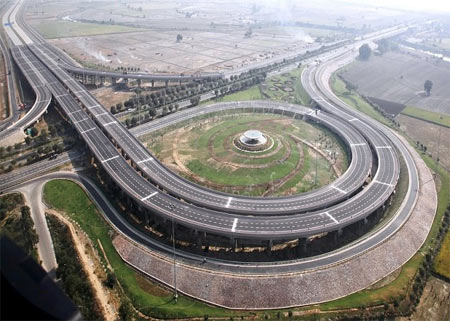Infrastructure
.
.
.
.
Faster than China? India's road, rail drive could lay doubts to rest
By Times of India
Prime Minister Narendra
Modi's reformist, but hard-up government has begun a splurge on road and
rail building that analysts say could remove doubts over whether economic growth in India really is overtaking China.

Having roughly doubled spending allocations for roads and bridges in
fiscal 2015/16, and raised the rail budget by a third, Modi is banking
on India going faster.
"They have acknowledged that
infrastructure is the big elephant in the room," said Vinayak
Chatterjee, head of infrastructure services company Feedback Infra.
"Once these measures are implemented, the elephant would start dancing, and with it the overall economy."
Modi's chief economic advisor, Arvind Subramanian, reckons growth could
increase by more than one percentage point this year provided
ministries don't under-spend, though the central bank saw it adding just
half a point.
READ ALSO: India yet to overtake China GDP, but we'll beat them soon: Arun Jaitley
Data released on Friday showed the economy grew 7.5 percent in the
quarter ending in March, easily outpacing China. Many economists
suspect, however, that the government statisticians' new way of counting
GDP overstates how well India is doing.
Those worries might
fade if Subramanian is right about the impact infrastructure spending
will have on India's under-achieving economy.
Success rests on
whether ministries spend the extra $11 billion they were allocated for
infrastructure this fiscal year. They got off to a fast start in April,
spending $6 billion of the $38 billion capital expenditure budget for
2015/16.
STEPPING UP
The government
has prioritized unblocking infrastructure projects that had gathered
dust because of either an obstructive bureaucracy, a lack of private
sector investment, or in some cases public interest litigation.
Weighed down with heavy debt, and having posted their worst results in
five years, big Indian corporates are in little rush to make fresh
investments, while public sector banks may require recapitalisation
before they are ready to lend the sums needed.
That has made the government step up to the plate.
Take Delhi's Eastern Peripheral Expressway, for example.
Part of a six-lane ring-road for the capital, the project was first
mooted nine years ago but failed to attract private bidders. Unwilling
to wait any longer, the road ministry intends spending almost $1 billion
building the 135 kilometre loop.
Last month, the cabinet
approved a policy that will provide private developers with a $470
million bailout in order to complete 16 highways.
The
government has also put $3 billion of seed capital into a new
infrastructure fund, with the hope of attracting up to $30 billion of
private money.
Some rules have been eased for the private sector, and financially stressed companies are now allowed to exit projects.
And in future, public tenders will only be launched after all approvals
have been secured - addressing a major reason why so many projects
stalled.
As a result the government hopes road building will
accelerate to 30 km a day by the end of next year from 12 km at present,
as it plans to award projects for 10,000 km of road this year, up 25
percent from a year earlier.

Some bureaucrats suspect that the
government has underestimated how much money is needed. Planned road
projects alone will cost $17 billion this year compared with a budget
allocation of about $7 billion. To cover most of the gap, the road
ministry plans to raise a $7 billion loan.

"We don't have
enough money to build all these roads," Rohit Kumar Singh, a mid-level
bureaucrat at the ministry, told Reuters. "We need to leverage private
sector funding."
 A clear, consistent policy on tolls needs to
be put in place for the private sector to become more active, Virendra
Mhaiskar, managing director of IRB Infrastructure Developers Ltd, one of
India's largest road builders, told Reuters.
A clear, consistent policy on tolls needs to
be put in place for the private sector to become more active, Virendra
Mhaiskar, managing director of IRB Infrastructure Developers Ltd, one of
India's largest road builders, told Reuters.

"You have to create an environment where investors and lenders can make a return," Mhaiskar said.




 A clear, consistent policy on tolls needs to
be put in place for the private sector to become more active, Virendra
Mhaiskar, managing director of IRB Infrastructure Developers Ltd, one of
India's largest road builders, told Reuters.
A clear, consistent policy on tolls needs to
be put in place for the private sector to become more active, Virendra
Mhaiskar, managing director of IRB Infrastructure Developers Ltd, one of
India's largest road builders, told Reuters.